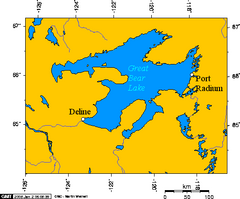Great Bear Lake
| Great Bear Lake | |
|---|---|
 |
|
| Map | |
| Location | Northwest Territories |
| Primary outflows | Great Bear River |
| Catchment area | 114,717 km2 (44,292 sq mi)[1][2] |
| Basin countries | Canada |
| Surface area | 31,153 km2 (12,028 sq mi)[1][2] |
| Average depth | 71.7 m (235 ft)[1][2] |
| Max. depth | 446 m (1,463 ft)[1][2] |
| Water volume | 2,236 km3 (536 cu mi)[1][2] |
| Residence time | 124 years[1] |
| Shore length1 | 2,719 km (1,690 mi) (plus 824 km (512 mi) island shoreline)[1][2] |
| Surface elevation | 186 m (610 ft) |
| Islands | 26 main islands, totaling 759.3 km2 (293.2 sq mi) in area[1] |
| Settlements | Deline, Port Radium |
| References | [1][2] |
| 1 Shore length is not a well-defined measure. | |
Great Bear Lake (Slavey: Sahtú, French: Grand lac de l'Ours) is the largest lake entirely within Canada (Lake Superior and Lake Huron straddling the Canada-US border are larger), the third largest in North America, and the seventh largest in the world.[3] The lake is situated on the Arctic Circle between 65 and 67 degrees of northern latitude and between 118 and 123 degrees western longitude, 186 m (610 ft) above sea level.
The lake has a surface area of 31,153 km2 (12,028 sq mi) and a total volume of 2,236 km3 (536 cu mi). Its maximum depth is 446 m (1,463 ft) and its average depth 71.7 m (235 ft). The total shoreline is 2,719 km (1,690 mi) and the total catchment area of the lake is 114,717 km2 (44,292 sq mi).
The lake empties through the Great Bear River (Sahtúdé) into the Mackenzie River. The only community on the lake is Deline at the southwest end.
In 1930, Gilbert LaBine discovered uranium deposits in the Great Bear Lake region.
The Sahtu Dene people took their name from the lake.
Contents |
Prehistory
Great Bear Lake lies between two major physiographic regions: the Kazan Uplands portion of the Canadian Shield and the Interior Plains. Originally it was part of the pre-glacial valleys that were reshaped by erosional effects of ice during the Pleistocene. Since then, the lake has undergone various changes resulting from post-glacial rebound following the melting of the ice.
Precambrian rocks of the Canadian Shield form the eastern margin of the McTavish Arm. These rocks of the Precambrian are made up of sedimentary and metamorphic deposits supplemented by igneous intrusions forming dikes and sills.
Climate
Great Bear Lake is covered with ice from late November to July.[2] Between 1950 and 1974, this climatic data set was collected at Port Radium:
| Month | Temperature | Precipitation | Bright sunshine (hours) |
|---|---|---|---|
| Jan | −27 °C (−16.6 °F) | 11 mm (0.43 in) | 0.19 |
| Feb | −27 °C (−16.6 °F) | 8 mm (0.31 in) | 1.82 |
| Mar | −19.1 °C (−2.4 °F) | 14 mm (0.55 in) | 7.57 |
| Apr | −10.7 °C (12.7 °F) | 6 mm (0.24 in) | 16.03 |
| May | 1.2 °C (34.2 °F) | 14 mm (0.55 in) | 21.76 |
| Jun | 9.0 °C (48.2 °F) | 14 mm (0.55 in) | 23.16 |
| Jul | 12.0 °C (53.6 °F) | 35 mm (1.38 in) | 18.54 |
| Aug | 10.6 °C (51.1 °F) | 43 mm (1.69 in) | 11.97 |
| Sep | 5.3 °C (41.5 °F) | 25 mm (0.98 in) | 6.20 |
| Oct | −3.2 °C (26.2 °F) | 27 mm (1.06 in) | 2.85 |
| Nov | −14.8 °C (5.4 °F) | 25 mm (0.98 in) | 0.39 |
| Dec | −23 °C (−9.4 °F) | 14 mm (0.55 in) | 0.00 |
| Average | −7.2 °C (19.0 °F) | 10 | |
| Total | 236 mm (9.29 in) |
Ice road
Great Bear Lake has one ice road, Deline ice road. It is used for few weeks out of the year to deliver supplies to the remote community of Deline. The speed on the ice road is 70 km/h (43 mph) just like the Tuktoyaktuk ice road because there are no portages or stretches of land within the lake. The ice road is used mostly by semi-trailer trucks and the road usually can handle 64,500 kg (142,000 lb). The road is subject to closure in late March due to warm weather.
From 1960 until 1985 an ice road corridor from Great Slave Lake up the Marian River, and then down the Camsell River system, serviced silver mines at Great Bear Lake. This road was constructed by ice road pioneer John Denison.
See also
References
- ↑ 1.0 1.1 1.2 1.3 1.4 1.5 1.6 1.7 1.8 Johnson, L. (1975), "Physical and chemical characteristics of Great Bear Lake", J. Fish. Res. Board Can. 32: 1971–1987 quoted at Great Bear Lake (World Lakes Database)
- ↑ 2.0 2.1 2.2 2.3 2.4 2.5 2.6 2.7 Hebert, Paul (2007), "Great Bear Lake, Northwest Territories", Encyclopedia of Earth, Washington, DC: Environmental Information Coalition, National Council for Science and the Environment, http://www.eoearth.org/article/Great_Bear_Lake,_Northwest_Territories, retrieved 2007-12-07
- ↑ Great Bear Lake. The Canadian Encyclopedia.
External links
- Great Bear Lake Watershed
- World Lakes Database
- Prehistory of Great Bear Lake
- 1867 account of the lake by William Carpenter Bompas
|
|||||||||||